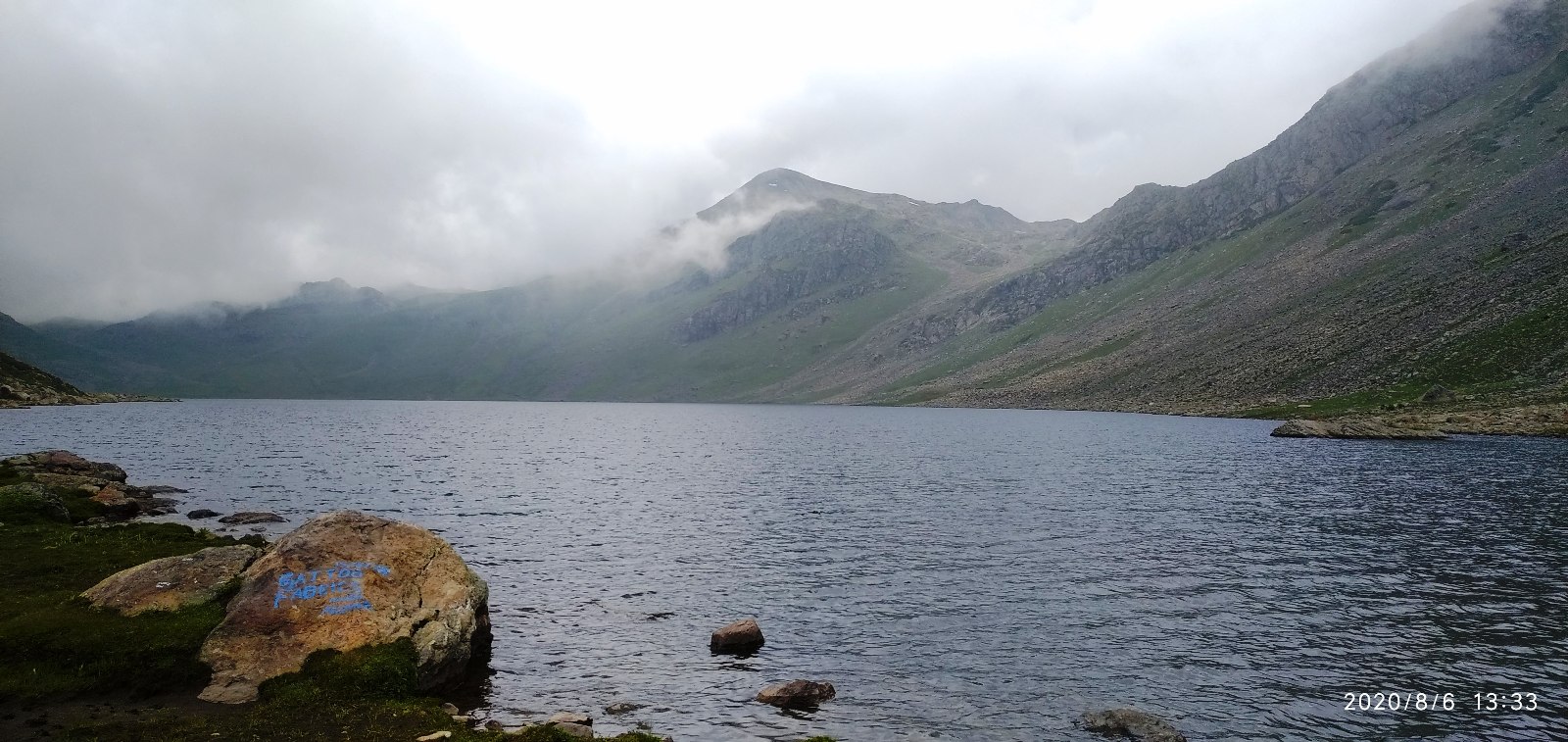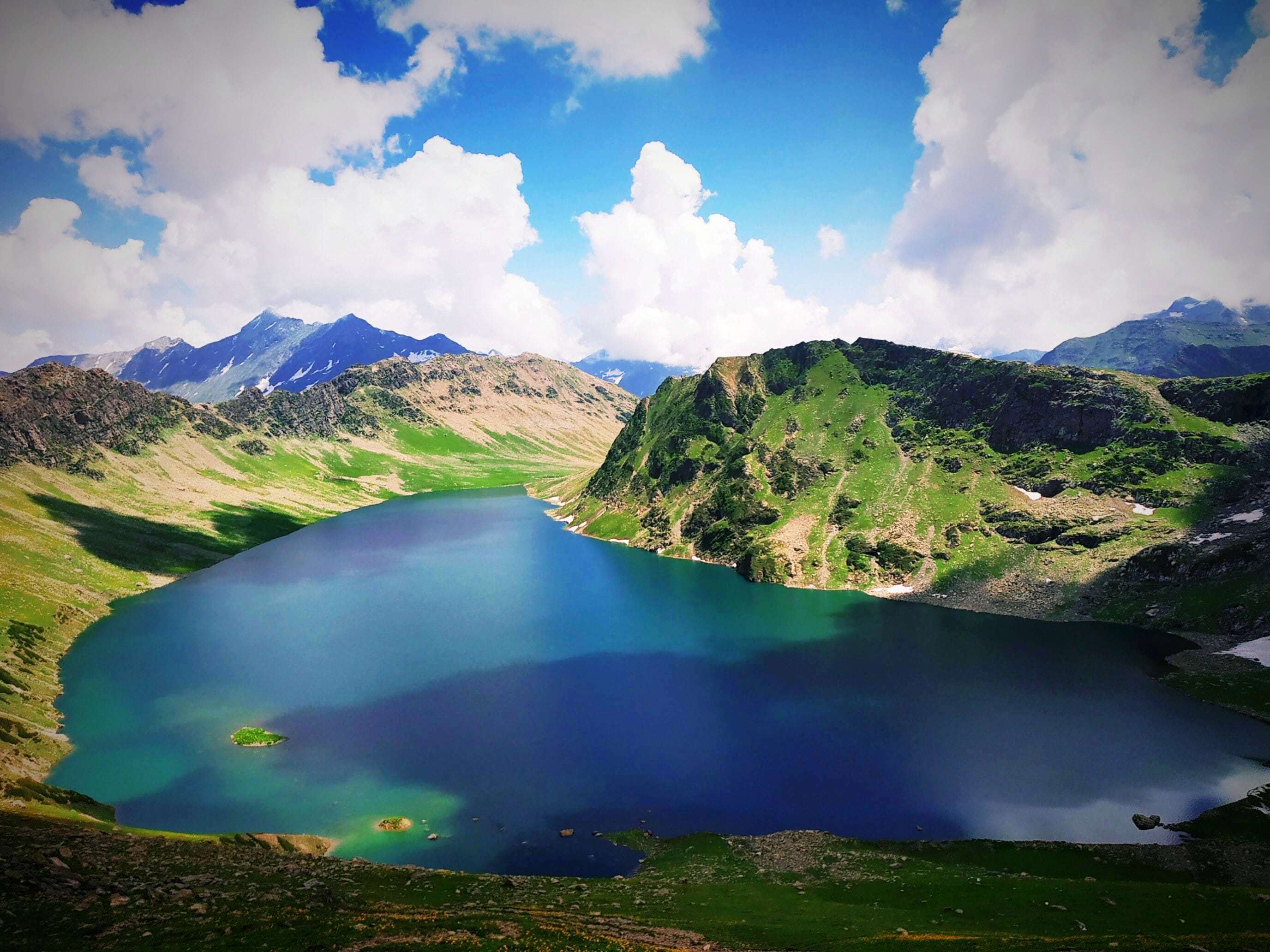by Basit Hassan
Marsar Lake is locally called a killer lake, a lake smaller in size than Tarsar with blue water. Marsar lake is a mysterious lake where camping is prohibited as suggested by the locals. It always plays hide and seek, being hidden for most times while visible for less.
Tarsar is an alpine lake changing its colours throughout the day while Marsar lake is being called a mysterious lake. The sixteenth-century Kashmiri ruler Yusuf Shah Chak is said to have known about these beautiful and pleasant looking lakes and has mentioned them in his poetry
When I remember the two tresses of the comely beloved,
Tears begin to flow from my eyes like streams from Tarsar and Marsar

The two Oligotrophic lakes are situated in the high altitude mountains of Himalayas of Aru belt, almost 22 km from Pahalgam at an altitude of about 3900 meters above sea level. Surrounded by snow-clad mountains, vast meadows and having gleaming waters adds to their existing exuberance.
Up to Aru, there is a motorable road, but after that one has to trek by foot. One can also visit these lakes via Tral, a sub-district of Pulwama. The track starts from the last village of Tral, Hajan to Nagbearan and finally to these beautiful lakes, but the trek being tough and not known to many except the locals is not preferred always.
The trek from Aru valley is a fairly easy one, so it is the preferred one. Along the way, one can have the best of view of mountains, green carpet like meadows, gushing water streams.
Tarsar Lake is the most beautiful one and is an almond-shaped lake and is 2 km in length and 0.8 km in breadth. It is separated by a mountain with a minimum peak elevation of 4,000 metres (13,000 ft) from another lake of the same nature known as Marsar. They are also known as twin sisters. The two lakes are separated by a distance of almost 4 km. One can have a view of both these lakes by reaching the top of a nearby mountain.
An interesting fact about Tarsar lake is that it changes its colour when viewed along its length. From turquoise to blue to green and grey, these colours are visible in brighter sunshine. Best time to visit these lakes is between July and mid-September.
We, a group of eight members started our trek from the spectacularly beautiful Aru valley after spending a night at this place. Aru valley has a unique scenic beauty, lush green meadows, mountains full of Deodar and pine and the fragrance of those soothes one’s mind and soul.
Early morning we hired ponies to carry our luggage. The horseman being very humble and kind-hearted enjoyed our company and educated us about the lesser-known places in that area. After trekking alternatively through dense forests and barren meadows for almost three hours we reached another camping site called Lidderwat. The route goes along the banks of Lidder rivulet. Lidderwat is an amalgam of two words – Lidder and wat meaning that two Lidder streams join each other. One Lidder stream derives its origin from great Kolhai glaciers and another one from the Tarsar lake, thus meeting at Lidderwat. At Lidderwat a huge number of camps are set up for the tourists and also local people pitch their tents in this impeccable place. It is a vast meadow with a way towards east leading to the great Kolhai mountains and towards the north are the sister lakes.
After having our lunch, we decided to move further. The trek now was a bit hectic one because of a steep rocky mountain. The view of Lidderwat started disappearing and new meadows full of tall grass were visible now. Tourists, in good numbers, were slowly moving along the way and clicking photographs of nomads and of the landscape.
We now needed to cross the stream, but the bridge seemed to be not so trustworthy, the only option was to crawl over it which we did successfully. After that, we encountered another group of trekkers from Pune who were very passionate to visit the lake but their physical condition was telling a different story. We clicked some photos and moved on
Finally, we reached Hamwas, a place on the bank of the stream at around 3 pm. Our horseman suggested us to pitch our tents there and we obliged. It was a trek of almost two hours from Lidderwat and everyone was feeling exhausted. Our first priority was to collect some firewood. Then some were assigned to set up the tents and prepare some food. For the first time during our trek, we were mesmerised by the views that the mountains, streams, pastures were presenting. We looked deep into nature and sunk into it.

Kothas (nomad houses) are seen everywhere and the nomads are always busy with their cattle. In our close proximity, a guy from the kotha approached us for some medicine as one of their child was having high fever. Fortunately, we had the medicine and gave it to him. Later they offered us some tea which was a nice gesture. We stayed for the night there and the experience was one to be remembered. Nights here are pretty much cool, so campfire becomes necessary first to give warmth and secondly for safety purposes. The sky presents the best possible view, as it is filled with densely packed and more visible brighter stars as is the case at high altitudes.
Early morning sun rays waked up everyone, the chirping of birds, the sound of water striking the big boulders do not allow one to sleep for too long. Then the best thing happened, the Kolhai mountain top was visible for a minute or two which is a rare scenario and suddenly got covered by the clouds. After finishing our breakfast we started to move ahead. After walking half an hour distance we found ourselves in another meadow called Sekwas.
Usually, Sekwas is preferred for the night stay instead of Hamwas. Tents of various colours were pitched everywhere and most trekkers were busy with their breakfast. Sekwas is a valley within a valley because apart from the entrance it is covered with barren mountains everywhere. The closer we were getting towards the lake, the more curious we were becoming. Everyone was ecstatic to have the first look of these pristine view lakes.
Finally, after trekking for almost three hours, we had our first look at the beautiful and gorgeous Tarsar lake. The sombreness went away in a jiffy. Everyone was over the moon and cried in jubilation just to experience the echoing sounds. Out came the cameras and mobile phones and the photo-shoot began. There was calmness and a sense of tranquillity everywhere.
The beauty of the lake mesmerised everyone. Not often you tend to synchronize with nature but here you are forced to. Everything looked picture perfect, here we were at an altitude of around 13000 ft experiencing the true colours of nature. The ripples in the water caused by the gentle breeze make it an awesome experience. A view one could dream of, the impeccable reflections of tall mountains, the bluish crystal clear water and an electric atmosphere was exhilarating us.
Walking along the length of this lake, the colours changed from blue to brown to greenish as a result of different sun angles, this thing is not seen in any of the alpine lakes. Almost half a dozen different colours were experienced by us.
After spending some quality time at this lake we decided to move towards Marsar lake. At the top of one of the mountains, both the lakes are visible, which is the best site for photographers. Marsar Lake is locally called a killer lake, a lake smaller in size than Tarsar with blue water. Marsar lake is a mysterious lake where camping is prohibited as suggested by the locals, which most of the times stay hidden under the shroud of thick clouds. It always plays hide and seek, being hidden for most times while visible for less.
Locals advise against staying for too long at this lake. There are a lot of myths regarding this lake. The water from Tarsar makes a stream of Lidder while that of Marsar moves in the opposite direction, passing from the beautiful meadows of Nagbearan to the Dachigam area of Srinagar.
Another lake by the name of Sundarsar, surrounded by beautiful mountains and carpet of yellow wildflowers, is located in the close proximity of these two lakes.

These lakes are probably most visited lakes because of the easier trek. Locals, tourists throng these places every year with zest and zeal. Thereby enjoying the breathtaking beauty of the land and also providing means of income to the locals. Everything at that point seems good but a negative aspect which everyone is carrying on their shoulders is a matter of concern i.e pollution.
The meadows, streams, mountain treks everything is polluted by the plastics and polythene and that really is excruciating. Even in these remote places, we tend to shy away from our responsibilities. Natural beauty is free of cost but by polluting these places it is going to cost us a lot. We should shoulder our responsibility of protecting and preserving these natural treasures. Otherwise, nature is surely going to take care of itself which can be anything.
(Basit Hassan a resident of Tral, is pursuing masters in mechanical engineering)















